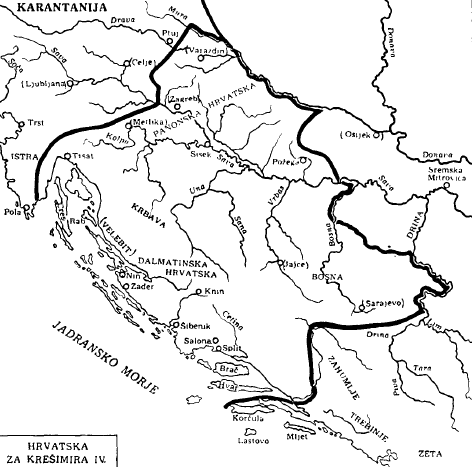Dalmatia through history.
Part III:
In previous 2 threads you could have read:
1) about the therm Dalmatia and what it meant in the time of creation
2) what was left of her after crash of Roman authority and arrival of Slavs
⬇️
Part III:
In previous 2 threads you could have read:
1) about the therm Dalmatia and what it meant in the time of creation
2) what was left of her after crash of Roman authority and arrival of Slavs
⬇️
https://twitter.com/Antimon_Zg/status/1351620068522795009?s=20
In this "sequel" we will see how Dalmatia, from the scattered cities and islands, has become what we consider Dalmatia today.
I will also explain where the historical pretensions of the Italians to Dalmatia came from.
Let's go in order.
⬇️
I will also explain where the historical pretensions of the Italians to Dalmatia came from.
Let's go in order.
⬇️
Everything we do and don't know about Dalmatia in the period of 2 centuries after the arrival of the Slavs, ie the end of organized Roman rule and written news about the events in it can be underlined and summarized by the provisions of the Peace treaty in Aachen, signed in 812. 



From that moment on, Dalmatia consisted of the municipal territories of the islands of #Krk, #Cres & #Lošinj (=#Osor) and #Rab, as well as the cities of #Zadar, #Trogir, #Split, #Ragusa (#Dubrovnik) and #Kotor.
THAT is what we consider #Dalmatia from that moment on.
⬇️
THAT is what we consider #Dalmatia from that moment on.
⬇️

What about the rest of former Dalmatian province?
More details you can read in pictures. We continue with true Dalmatia.
⬇️

More details you can read in pictures. We continue with true Dalmatia.
⬇️


From the Constantinople POV, Dalmatia was far and territorial spreaded province very hard to rule. In praxis every coastal or island community developed in some kind of autonomous political unit with formal sovereign of Roman Emperors.
⬇️
⬇️

They tried to organized it as military unit – a Thema of Dalmaita – from 871 (emperor Basil I). Zadar was designated as a metropolis and Byzantinne strategists sat there as representatives of the Roman government. 

Although sometimes the managers of Dalmatia were Croatian rulers from the hinterland, as well as Venetian doges, it remains an indisputable fact that by the end of the 11th century it formally and legally maintained as the territory of the Roman Empire (Byzantium).
⬇️
⬇️
One of the turning points was in 1075, when Pope Gregory VII crowned Dmitar Zvonimir for the king of Croatia and Dalmatia in the city of #Solin.
In this way Dalmatia (except Dubrovnik and Kotor) was formally and legally united with the Kingdom of Croatia.
⬇️
In this way Dalmatia (except Dubrovnik and Kotor) was formally and legally united with the Kingdom of Croatia.
⬇️

After the death of the Croatian-Dalmatian king Stephen II (1091) and a decade of vicissitudes, the Croatian nobility accepted the Hungarian king Coloman (Kalman) as the new Croatian-Dalmatian king and he was crowned in #Biograd in 1102.
#Dalmatia recognized him in 1105.
#Dalmatia recognized him in 1105.

Since then, the Republic of Venice, then a rich independent trading state, powerful enough to pursue a policy independent of Constantinople, has been fighting for Dalmatia more and more vigorously.
That was "international" conflict between two independent states.
⬇️
That was "international" conflict between two independent states.
⬇️

As a maritime state, the conquest of Dalmatian towns and islands was a strategic goal for it, which enabled a safe trade sea path to the Mediterranean.
However, Dalmatian-Croatian kings had political legitimacy (since 1102).
⬇️
However, Dalmatian-Croatian kings had political legitimacy (since 1102).
⬇️

To enumerate all the changes of government in individual Dalmatian cities would really go beyond the scope of this topic.
One year should be noted yet, 1357-1358.
⬇️
One year should be noted yet, 1357-1358.
⬇️
Then the Hungarian-Croatian King Louis I of #Anjou waged a great war against Venice and inflicted a defeat so fierce that the Venetians, by signing the Peace of #Zadar (1358), renounced all rights to Dalmatia from Kvarner to Durres.
⬇️
⬇️

Year of 1358 is also significant for the fact that #Dubrovnik came under the rule of the Hungarian-Croatian-Dalmatian kings for the first time (and ever since), sharing the fate with other Dalmatian cities and Croatian lands.
⬇️
⬇️

#Kotor then recognized the rule of Serbian rulers (since 1185) who, on the basis of government over this one Dalmatian town, for centuries adorned themselves with the title of kings of Dalmatia.
⬇️
⬇️
This situation lasted for the next 50 years.
The Republic of Venice, meanwhile, recovered but since the provisions of the peace of Zadar (1358) renounced all rights to Dalmatia, it lacked the legitimacy to try anything.
⬇️
The Republic of Venice, meanwhile, recovered but since the provisions of the peace of Zadar (1358) renounced all rights to Dalmatia, it lacked the legitimacy to try anything.
⬇️
And then came the year of 1408.
And there came the opportunity to restore this legitimacy in any kind of form.
And there came the opportunity to restore this legitimacy in any kind of form.
Kingdom of Hungary was in constant civil war from 1386 til 1409 fought between the supporters of 2 throne pretenders - Sigismund of Luxembourg and Ladislaus of Naples.
Both were by their supporters recognized and even crowned as legitimate kings of Hungary, Croatia and Dalmatia.

Both were by their supporters recognized and even crowned as legitimate kings of Hungary, Croatia and Dalmatia.

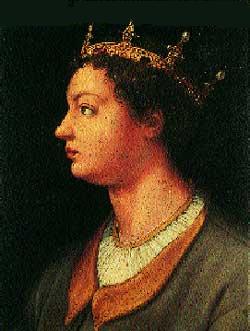
Most of the #Slavonia, #Croatia, #Bosnia, #Hum and #Dalmatia stood behind king Ladislaus of Naples, who even had a support of the pope.
There was a formal coronation in Zadar for the king of Hungary, Croatia, Dalmatia in 1403.
There was a formal coronation in Zadar for the king of Hungary, Croatia, Dalmatia in 1403.

While the supporters of the 2 candidates "slaughtered" each other, both rulers sought an alliance of Venice against the other one.
Venice rejected them both.
She just watched the 2 kings of "Croatia and Dalmatia" fight among themselves.
And she waited for the opportunity.
⬇️
Venice rejected them both.
She just watched the 2 kings of "Croatia and Dalmatia" fight among themselves.
And she waited for the opportunity.
⬇️
From 1403 to 1409, King Sigismund began to gain the upper hand and the number of nobles loyal to Ladislaus slowly melted away.
In 1409 the territory in which the king Ladislaus had influence and control consisted of #Zadar, #Novigrad, #Vrana and the island of #Pag.
In 1409 the territory in which the king Ladislaus had influence and control consisted of #Zadar, #Novigrad, #Vrana and the island of #Pag.
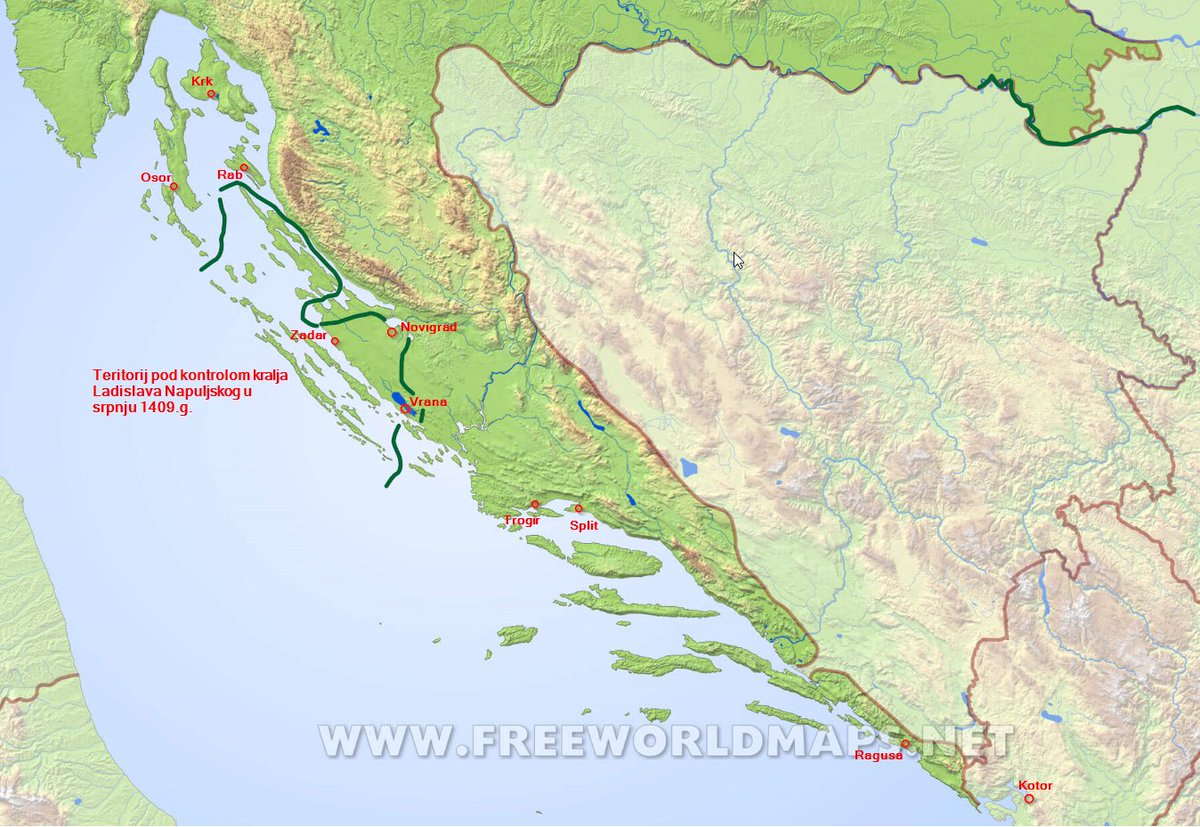
When he saw that he was losing the "ground under his feet" and while the nobles loyal to him on the ground were still fighting for his cause, in July 1408 he secretly addressed Venice by offering them Zadar and all those cities that recognized his supreme authority for MONEY.
⬇️
⬇️
All the offers and course of the negotiations is too extensive topis for twitter; Venice's position was only - an unequivocal renunciation of rights over Dalmatia and Croatia (primarily Dalmatia) by Ladislaus in favor of Venice for as little money as possible. 

The secret negotiations lasted for a year and were completed on July 9, 1409.
At that time, King Ladislaus was recognized only in Zadar with the district, Novigrad, Vrana and the island of Pag.
The rest of his former territories and nobles recognized king Sigismund as king.
At that time, King Ladislaus was recognized only in Zadar with the district, Novigrad, Vrana and the island of Pag.
The rest of his former territories and nobles recognized king Sigismund as king.

But according to the letter of the contract, Venice bought for 100,000 ducats everything that Ladislaus held at that time, as well as what Ladislaus renounced (and did not hold) in her favor, and that is the title of the ruler of Dalmatia.
In this way Venice bought legitimacy.
She knew it was "thin" and that King Sigismund would not recognize it, but she got it and was prepared to defend it with weapons if necessary.
Already in July 25 2 ships sailed towards Zadar.
She knew it was "thin" and that King Sigismund would not recognize it, but she got it and was prepared to defend it with weapons if necessary.
Already in July 25 2 ships sailed towards Zadar.

Until August 24 they established government in #Zadar, #Novigrad, #Vrana and #Pag without any fight.
#Nin itself recognized their government in September 16 and by that time they installed their people on the islands of #Cres and #Lošinj.
#Nin itself recognized their government in September 16 and by that time they installed their people on the islands of #Cres and #Lošinj.

In October 1409 Venice started few years long siege of #Šibenik, who rejected their call to recognize Venice as high authority.
In Dezember 1490 they drove out count Nicholas IV #Frankopan from the island of #Rab.
In Dezember 1490 they drove out count Nicholas IV #Frankopan from the island of #Rab.
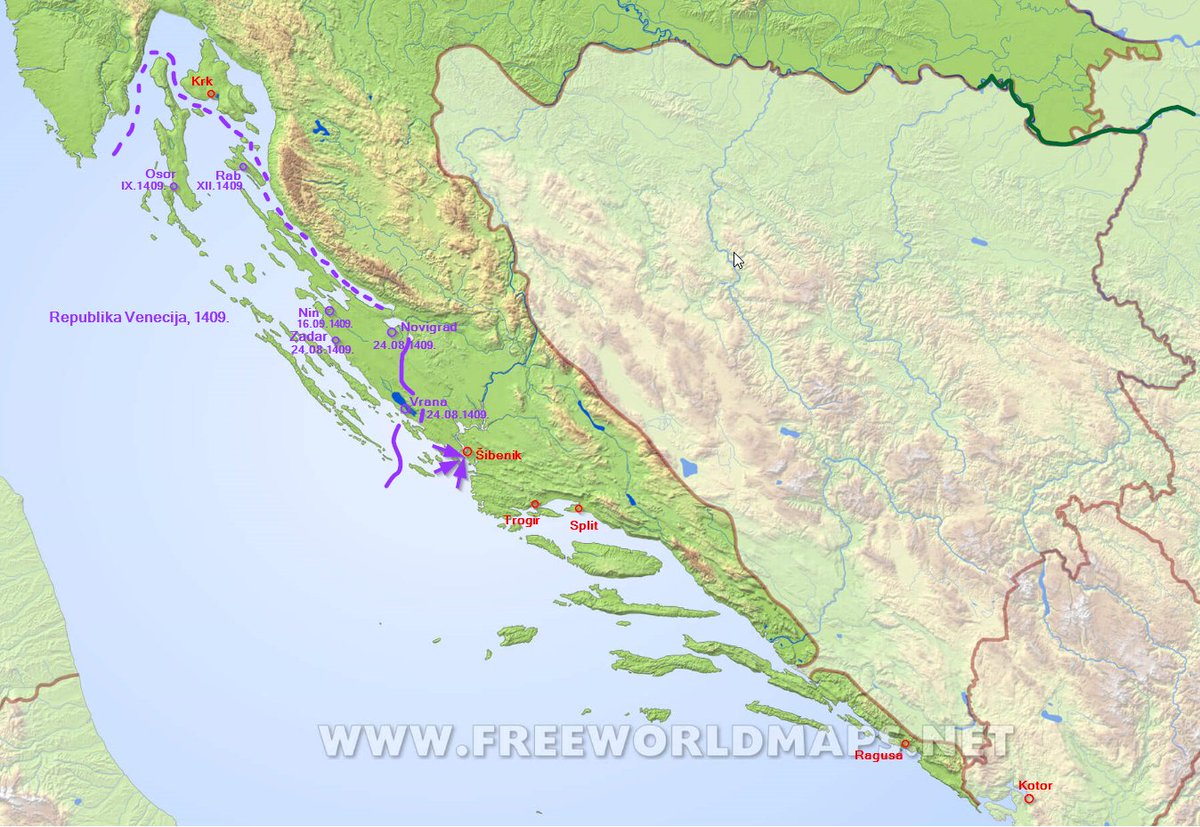
Without effective help from king Sigismund, #Šibenik surrendered to Venice on October 30, 1412 after 3 years long siege. 



In 1420 #Kotor was the 1st to recognize high authority of Venetian dodge (April 1) and soon after it island of #Korčula (April 24).
City of #Trogir surrendered after few months of trade embargo (June 22) and few days later #Split did the same (June 28), #Brač and #Hvar also.
City of #Trogir surrendered after few months of trade embargo (June 22) and few days later #Split did the same (June 28), #Brač and #Hvar also.

Where was king Sigismund? Why he didn't interfere?
He did announce formal war to Venice but he was busy with Ottomans who started to install constant political control over Bosnia and dual puppet state (despotate) of Serbia.
He did announce formal war to Venice but he was busy with Ottomans who started to install constant political control over Bosnia and dual puppet state (despotate) of Serbia.
He had obligation to fight with Venice, and yet, it was his only capable and natural ally vs Ottomans.
Hungary and Venice signed peace in April 1433.
Therefore Sigismund accepted all Venetian occupied territories.
And it remained in their government til 1797.
Hungary and Venice signed peace in April 1433.
Therefore Sigismund accepted all Venetian occupied territories.
And it remained in their government til 1797.
On February 22, 1480 Venetians captured the last Croatian free island of #Krk.
It was the formal and practical end of 3 centuries long government of Croatian noble family #Frankopan over the island.
It was the formal and practical end of 3 centuries long government of Croatian noble family #Frankopan over the island.

All those territories under Venetian rule were considered as Venetian Dalmatia.
There were also temorary expansions, f.e. #Omiš and #Poljica recognized Venice in January 1444, #Krajina July 16, 1452 and #Neretva in 1465.
There were also temorary expansions, f.e. #Omiš and #Poljica recognized Venice in January 1444, #Krajina July 16, 1452 and #Neretva in 1465.
All those temporary expansions were lost in Ottoman expansion towards west during 16th century, when they captured most of (but not all) Croatian lands.
It remained so until the end of 17th century.
It remained so until the end of 17th century.
In the anti Ottoman wars 1699-1700 they managed to liberate some hinterland cities and added them to their former possessions (Acquisito Nuovo) and last phase of expansion was in 1718-1723 (Acquisito Nuovissimo).
All those Venetian possessions bore the name Dalmatia.

All those Venetian possessions bore the name Dalmatia.


We can easily see that today's borders between Croatia and BiH in region of Dalmatia correspond with those established in 1723 between then Venezia (Dalmatia) and Ottoman empire. 



Venetian Dalmatia lasted until 1797 when Napoleon Bonaparte conquered and abolished Venetian Republic.
He abolished Republic of Dubrovnik in 1805.
Both were added to newly organized Illyrian provinces 1809-1813.

He abolished Republic of Dubrovnik in 1805.
Both were added to newly organized Illyrian provinces 1809-1813.


When France capitulated, Illyrian provinces were restored in Austrian-Hungarian Monarchy.
Dalmatia was put under direct control of Austria, while the rest of Croatia remained in domain of Hungary.

Dalmatia was put under direct control of Austria, while the rest of Croatia remained in domain of Hungary.


Islands of Krk, Cres & Lošinj and Rab remained out of reach of then Dalmatia while ex. Republic of Dubrovnik became part of it, together with Kotor which was part of Venetian Dalmatia from 1420. 

In those borders Dalmatia as one of Croatian crown lands joined new proclaimed State of Slovenes, Croatians and Serbs (1918), and in the same year joined in Kingdom of Serbs, Croats and Slovenes, later called Yugoslavia.
During both Yugoslavias, Kotor slowly fell out of what we consider to be a Dalmatia.
And that is how we came to today's modern form of region of Dalmatia.
And that is how we came to today's modern form of region of Dalmatia.

Most of it was a very core of Croatian medieval state.
What about Italian territorial claims over Dalmatia?
What about Italian territorial claims over Dalmatia?
Well, when Garibaldi conquered all the Apenini peninsula in 19th century forming Italian state and later Italian nation, their modern nationalists claim that Italia is successor of ex. Venetian Republic and thus a legit successor of all their former holdings on the east Adriatic.
On that ground a mantra inside many Serbian (pseudo)historians and nationalists grew how in fact it was Serbia, or union with Serbs saved Croats from military intervention from Italy and probable loss of Dalmatian territories after 1918.
Last time when Italy satisfied their territorial pretensions on Dalmatia was in 1941-1943 when leader of Independent State of Croatia Ante Pavelić had to gave up from some Dalmatian territories in favor of Mussolini's Italy. 
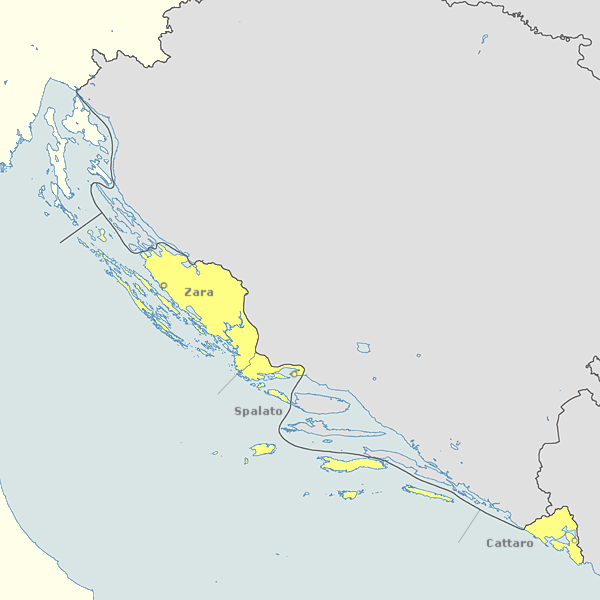
Throughout history the Croatian people have proved to be indestructible despite unfavorable circumstances.
He stayed on his own ground and lost a good part it.
He let others into his house, they spat in his face.
He stayed on his own ground and lost a good part it.
He let others into his house, they spat in his face.
One Dalmatian song says "whoever writes his history on a hard rock, no one can erase its past".
Today, the Croat stands proudly on his own, as so does the Croatian Dalmatia.



Today, the Croat stands proudly on his own, as so does the Croatian Dalmatia.




👆🏽
#dalmatia #historyofdalmatia #dalmatiathroughhistory #historyofcroatia #historyofcroats #croatianhistory #history #croatia #krk #cres #lošinj #rab #zadar #trogir #split #pag #kotor #dubrovnik #croatiankingdom #hrvatskokraljevstvo
#dalmatia #historyofdalmatia #dalmatiathroughhistory #historyofcroatia #historyofcroats #croatianhistory #history #croatia #krk #cres #lošinj #rab #zadar #trogir #split #pag #kotor #dubrovnik #croatiankingdom #hrvatskokraljevstvo
Dubrovnik Republik abolished 1808.
• • •
Missing some Tweet in this thread? You can try to
force a refresh












